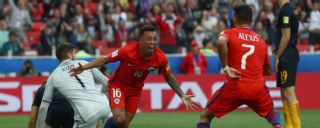|
The Arnie-ball World Tour will be heading to Argentina next year, with Australia drawn in Group A to face La Albiceleste, Bolivia, Chile, Paraguay, Uruguay at the 2020 Copa America. Here's what to expect from the Socceroos' five opponents: ArgentinaBrimming with talent in the front third -- including an extraterrestrial who won his sixth Ballon d'Or earlier this week -- but cripplingly imbalanced. As a consequence, Paulo Dybala has only been used sparingly despite his mesmerising talent -- to the point where he did not even see a minute in this year's Copa America semifinal, as Argentina "chased" the game against Brazil. Something that must be considered with Lionel Messi's disparate performances for club and country, La Albiceleste have suffered in possession from an ultra-conservative midfield for years. It reached a point of critical mass at the 2018 World Cup in Russia, with Jorge Sampaoli starting with the likes of Enzo Perez, Lucas Biglia and -- despite his emotional presence -- Javier Mascherano. Much like his predecessors, current coach Lionel Scaloni has been faced with the burden of fitting a team around the 32-year-old Messi. Scaloni has at least tried to figure out a means to penetrate from earlier phases of possession, giving more scope to the likes of Leandro Paredes and Giovani Lo Celso. Dybala, however, remains key to that aim. ChileThere was a lingering sense Chilean football was leading to that point, but this year's Copa America was a colossal moment for an ageing generation. With the majority of possession, Chile were soundly beaten by Peru in the semifinal, after struggling against Ecuador, Uruguay and Colombia earlier in the tournament. Looking back, Australia's effectiveness as the reactive team in their last meeting against Chile at the 2017 FIFA Confederations Cup was another momentary hint. The likes of Arturo Vidal, Alexis Sanchez and Eduardo Vargas might have remained but they lacked the clarity and movement in possession that players like Jorge Valdivia and Mati Fernandez provided. Charles Aranguiz was and remains another who requires a reference point in Chilean phases of possession. While Erick Pulgar has emerged as one of the better defensive midfielders in Serie A, quickly becoming a key player after his transfer to Fiorentina this summer, the primary attributes he is providing are energy and distribution. While they are resolute, hard-working and have individual quality, a team can sit in a block against Chile and wait for triggers to press and transition. ParaguayAfter three disappointing tenures at club level in Spain, Eduardo Berizzo has gone the blank canvas method with Paraguay, selecting 44 players for his 14 matches in charge. With a sparsity in attacking talent on top of his own practical ideology, Berizzo has naturally implemented a counter-attacking plan, seeking to maximise Miguel Almiron's pace on the break. Despite high defensive positioning at times, Paraguay have been more inclined to contain than press. Despite possible reservations on aesthetic, the Albirroja benefitted from the tournament format in Brazil this year, securing a quarterfinal berth as one of the best third-placed teams. Without winning a game for the whole tournament, Paraguay were close to securing a semifinal place by knocking out the hosts, but fell on penalties following Derlis Gonzalez's agonising miss. Qualification for the 2022 World Cup looks to be top of the list of priorities, but Paraguay will be competitive regardless. UruguayThe Socceroos might have history with Uruguay and the infinite pragmatism/wisdom of Oscar Washington Tabarez, but the Celeste are a far different team to what we faced in 2002 and 2006 World Cup qualification playoffs. Aside from an astonishing understanding that borders on telepathy, Luis Suarez and Edinson Cavani remain one of the most dynamic strike partnerships in international football. A lean period following the 2011 Copa America triumph -- which a round-of-16 exit at the 2014 World Cup and a group-stage exit at the 2016 Copa America Centenario -- Uruguay have been bolstered by a regenerated midfield. Tabarez has both quality and variety to choose from in his midfield stocks, with Rodrigo Bentancur, Lucas Torreira and Matias Vecino providing a necessary link to Suarez and Cavani. Federico Valverde's emergence has only strengthened that depth. The one thing Uruguay have lacked in a tactical sense is width. Although Nahitan Nandez is by no means incapable, much like Graham Arnold's teams, the bulk of attacking in wide areas comes from the full-backs. Despite his years, Martin Caceres is compatible in that sense. BoliviaUnderlining the benefits of accepting the invitation to play in Copa America, the Socceroos have never even played a friendly international against Bolivia. It will provide an opportunity to learn and adapt, with qualification for the 2022 World Cup on the horizon. The opening game of this year's Copa America proved a precursor for the rest of the tournament, as Eduardo Villegas' side sat in a block with relative effectiveness against host nation Brazil. The complexion of the match only changed with Nestor Pitana going to VAR, to gift the Selecao the lead. With Cesar Farias taking over following the tournament, signs of improvement were hard to find, as Venezuela won 4-1 in his opening game. A largely home-based squad, and lacking in goals, to the point where 40-year-old Carlos Saucedo was called up for the last international window.
|

